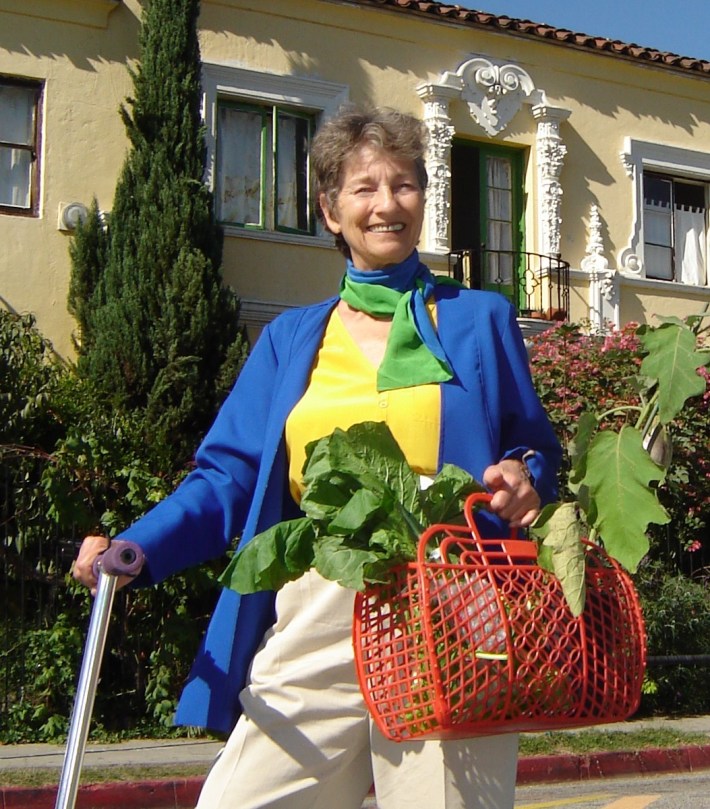Streetsblog L.A. is continuing coverage of Los Angeles' draft Mobility Plan 2035. The draft plan is out for comment; SBLA profiled it here. The public is encouraged to submit comments via email, or at a series of Planning Forums taking place through April 12th. The next forum is this Saturday March 29th, 9 a.m. to noon, at Boyle Heights City Hall, 2130 E. First St., L.A. 90033.
Streetsblog has asked some local livability leaders to respond to a few simple questions telling us their opinions of the city of Los Angeles draft Mobility Plan 2035. Yesterday we published responses from Bicycle Advisory Committee chair Jeff Jacobberger and Multicultural Communities for Mobility chair Betty Avila. Today's respondents are L.A. Eco-Village's Lois Arkin and Bikesan@s Del Valle's Carlos Hernandez.
We'll have even more community voices on the Mobility Plan later this week.
Lois Arkin lives and works in the Los Angeles Eco-Village demonstration neighborhood, which she co-founded in 1993. She is the Executive Director and founder of CRSP (Cooperative Resources and Services Project.) She is the co-author and editor of two books on urban sustainability and cooperatives, and represents the Western U.S. on the Council of the Ecovillage Network of the Americas.
What's your overall opinion of Mobility Plan 2035?
Arkin: I am very pleased with much of the attention to pedestrian and bicycle strategies, with good quality-of-life language. It makes one appreciate that city planners are actually transitioning from 1950s thinking, seen especially in the LADOT.
What do you like best in the plan?
The ideas expressed regarding safety and happiness. Possibilities for pedestrians, bicyclists, kids, seniors, disabled. The beginnings of language that suggests that there are too many cars and trucks and that a multi-modal approach is gaining acceptance.
What do you think is missing or needs work?
Still too much bias for cars. We need to regulate the reduction of cars, trucks, and vehicle congestion in general.
Since this Transportation Element goes to 2035, and L.A. still has the worst air in the U.S., I'd like to see a mandated reduction of 5% per year of cars and trucks registered within the city of Los Angeles over the next 15 years. With no (or minimal) loopholes. Or creating a very high city vehicle tax, which might accomplish the same thing. Combined with congestion pricing, this might begin to address our air quality, congestion, and safety issues.
Prohibit street widening.
Need much more attention to pilot demonstrations for car-free neighborhoods and collaborative "smart" parking districts, so these become normal options after a decade or so. Plus no net new parking in the city.
Lastly, please quantify all the auto amenities in the city and then reduce them incrementally as more and more pedestrian, bicycle, and transit amenities come online (great PhD thesis project).
Carlos Hernandez is a worker, student, and uncle.He co-founded Bikesan@s Del Valle bike co-op, and calls himself a "proud Valley boy." He is developing a bike share and bike co-op in North Shore, Coachella with Kounkuey Design Initiative.
My overall opinion of the Mobility Plan 2035 is that it's comprehensive. It covers a lot of multi-modal transit options, crossed its t's, and dotted its i's.
What do you like best in the plan?
What I like best in the Mobility Plan is its demographic shift. It's apparently advocating for a new generation that is less dependent on cars and drives less overall (my generation, right?!) So a plan like this is aimed at young, hip, good looking people (me?), working folks, and the elderly. The added Complete Streets Manual is great (and dense!), and cars are still really expensive.
What do you think is missing or needs work?
So what is the plan missing? I think it needs work in terms of access. I'm curious to know how many other people get a chance to read the document? Is it published in other languages? Is there an abridged version that shows a priority schedule? That would be great. I'd also like to see Measure R funds really step it up in terms of funding bike/ped infrastructure. North-South Valley connections for bicycles are also a plus!
It's a general plan document and is vague/subjective, but I think it's also taking the right steps.
More interviews later this week.
Photo credit: Header bus image by downtowngal via Wikimedia









